(完整word版)971_英语教学论
- 格式:doc
- 大小:18.01 KB
- 文档页数:1
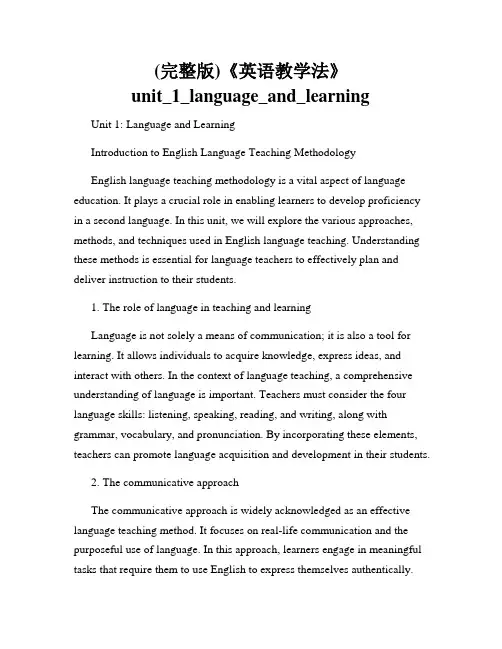
(完整版)《英语教学法》unit_1_language_and_learning Unit 1: Language and LearningIntroduction to English Language Teaching MethodologyEnglish language teaching methodology is a vital aspect of language education. It plays a crucial role in enabling learners to develop proficiency in a second language. In this unit, we will explore the various approaches, methods, and techniques used in English language teaching. Understanding these methods is essential for language teachers to effectively plan and deliver instruction to their students.1. The role of language in teaching and learningLanguage is not solely a means of communication; it is also a tool for learning. It allows individuals to acquire knowledge, express ideas, and interact with others. In the context of language teaching, a comprehensive understanding of language is important. Teachers must consider the four language skills: listening, speaking, reading, and writing, along with grammar, vocabulary, and pronunciation. By incorporating these elements, teachers can promote language acquisition and development in their students.2. The communicative approachThe communicative approach is widely acknowledged as an effective language teaching method. It focuses on real-life communication and the purposeful use of language. In this approach, learners engage in meaningful tasks that require them to use English to express themselves authentically.The communicative approach encourages learners to develop their fluency and accuracy by providing opportunities for interaction and authentic communication.3. The lexical approachThe lexical approach emphasizes the importance of teaching vocabulary and collocations in language learning. It recognizes that grammar and vocabulary are interconnected and that learners must acquire both to communicate effectively. Teachers following the lexical approach prioritize teaching high-frequency and useful vocabulary, as well as the collocations and phrases associated with them. By developing a strong lexical repertoire, learners can enhance their language proficiency and understanding.4. Task-based language teachingTask-based language teaching (TBLT) is a learner-centered approach that focuses on the completion of meaningful tasks. In TBLT, learners are presented with a task that requires the use of language to accomplish a specific goal. These tasks can be simulations of real-life situations or problem-solving activities. By engaging in these tasks, learners develop their language skills while also achieving the task objective. TBLT promotes both language acquisition and the development of critical thinking and problem-solving skills.5. Technology-enhanced language teachingTechnology has revolutionized language teaching and learning. It provides teachers and learners with access to an array of digital resources and tools. Technology-enhanced language teaching encompasses the use ofeducational software, online platforms, multimedia materials, and interactive activities. It enhances learner engagement and provides opportunities for independent learning. Integration of technology in language teaching opens up new possibilities for personalized and adaptive instruction.ConclusionEnglish language teaching methods continually evolve to meet the needs of diverse learners. It is essential for language teachers to keep abreast of current approaches and techniques to maximize instructional effectiveness. The approaches discussed in this unit, including the communicative approach, lexical approach, task-based language teaching, and technology-enhanced language teaching, provide teachers with valuable frameworks to deliver comprehensive and engaging language instruction. By applying these methods, language teachers can foster language learning and promote language proficiency development in their students.(Word count: 585)。

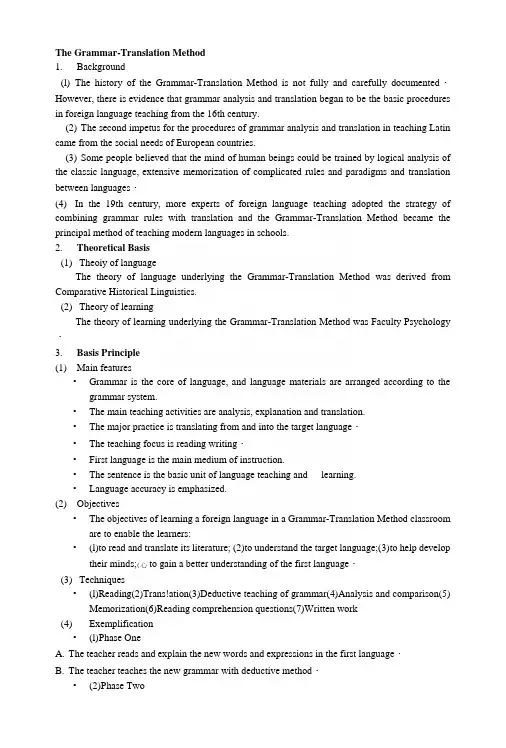
The Grammar-Translation Method1.Background(l)The history of the Grammar-Translation Method is not fully and carefully documented・However, there is evidence that grammar analysis and translation began to be the basic procedures in foreign language teaching from the 16th century.(2)The second impetus for the procedures of grammar analysis and translation in teaching Latin came from the social needs of European countries.(3)Some people believed that the mind of human beings could be trained by logical analysis of the classic language, extensive memorization of complicated rules and paradigms and translation between languages・(4)In the 19th century, more experts of foreign language teaching adopted the strategy of combining grammar rules with translation and the Grammar-Translation Method became the principal method of teaching modern languages in schools.2.Theoretical Basis(1)Theoiy of languageThe theory of language underlying the Grammar-Translation Method was derived from Comparative Historical Linguistics.(2)Theory of learningThe theory of learning underlying the Grammar-Translation Method was Faculty Psychology ・3.Basis Principle(1)Main features•Grammar is the core of language, and language materials are arranged according to the grammar system.•The main teaching activities are analysis, explanation and translation.•The major practice is translating from and into the target language・•The teaching focus is reading writing・•First language is the main medium of instruction.•The sentence is the basic unit of language teaching and learning.•Language accuracy is emphasized.(2)Objectives•The objectives of learning a foreign language in a Grammar-Translation Method classroom are to enable the learners:•(l)to read and translate its literature; (2)to understand the target language;(3)to help develop their minds;(心to gain a better understanding of the first language・(3)Techniques•(l)Reading(2)Trans!ation(3)Deductive teaching of grammar(4)Analysis and comparison(5) Memorization(6)Reading comprehension questions(7)Written work(4)Exemplification•(l)Phase OneA.The teacher reads and explain the new words and expressions in the first language・B.The teacher teaches the new grammar with deductive method・•(2)Phase TwoA. Students are asked to read a few sentences out aloud and translated them into the first language ・B. The teacher analyses some difficult sentence and translates them into their native language・C- Students read the studied part of the passage silently and ask the teacher questions they can not answer by themselves.•(3)Phase ThreeA. Students are asked to write the answers to the questions about the reading passage.B .Students are asked to do other written work that is meant to reinforce the new grammar items and vocabulary・4.Summary and Comments(1)Main Advantages•(DIt makes use of the first language・ In Grammar-Translation Method, the first language is maintained as the reference system in the learning of the second language・•(2)It helps students develop reading comprehension and production of written language・•(3)It is easy for teacher to use. The Grammar-Translation Method makes few demands on teacher although it often creates frustration for students. It is relatively easy to apply. (2)Disadvantages(l)O veremphasis on translation, dependence on first language. Overemphasis on translation can never emancipate the learners from dependenee on the first language.(2)Too much emphasis on reading and writing, neglect of listening and speaking. It put too much emphasis on reading and writing and neglects listening and speaking.(3)Not meeting the communicative and practical needs of the students・ Knowing a largenumber of grammatical rules can not ensure that students can use them appropriately in real communicative situation. The texts are mostly taken from literary works. The language learned often doesn' t meet the practical needs of the learners・(4)Rote-learning Memorizing grammar rules and bilingual word lists does not motivatestudents to actively communicate in the target language・The Direct MethodLBackground•Use the natural way to communicate, like a baby learning its mother tongue・•In the late 19th century in Europe, for economic development, the communication among nations became more frequent.•Foreign languages learning was highly demanded・•Oral communication became the main goal of foreign language teaching・•Revolution to Grammar Translation Method・One of the revolutionists was Francois Gouin.•First introduced in France and Germany.•Berlitz (Maximilian D. Berlitz,! 852-1921) used extensively in Rhode Island, USA, and opened the first language school2.Theoretical BasisThe theory of language mainly derives from the following views proposed by the innovators and reformers of the 19th century:Every language has its own structure and cannot be forced into the straitjacket of Latin gDimmar.Speech patterns rather than grammar should be the fundamental elements of language・•Training in phonetics will enable teachers and students to pronounce the language accurately.•The sentence is a more useful unit of language instruction. The verb no less important than the noun to which language pedagogy had previously paid much more attention.3.Basic Principles(1)> Main featuresThis method aims at developing the students J ability to communicate in the target language. The first language and translation exercises are completely avoided・ The syllabus used in the Direct Method is arranged semantically according to situations to topics-(2). ObjectivesThe objectives are to foster the students * ability to communicate in the target language・(3). TechniquesIn order to realize the goal of teaching, a Direct Method teacher is usually found using the following techniques:Direct association Question and answer exercises Conversation practiceError correction Dictation(4). Inductive teaching of grammarGrammar is by no means taken for granted by most practitioners of the Direct Method.•l)Listening comprehension takes 2) Graded composition4.ExemplificationClassroom procedures in the Direct Method can be roughly divided into three phase:(1). Presentation by direct association (2). Oral practice in the target language(3)・ Consolidation with written work5.Summary and Comments(1)> Advantages•It is necessary in efficient real communication.•It is important in achieving automaticity of using the target language・•Special attention paid to pronunciation and intonation is desirable in teaching spoken language.•It is strategic in fostering the four skill.•It makes foreign language learning more natural and efficient for students to understand.(2). Dissatisfactory•It results in the exclusive tongue occasionally troubles the Direct Method in teaching the meaning of abstract concepts.•It is difficult for students to safeguard against mistakes and self-correct them with the guidance of the rules of the target language・•It requires teachers who have native-speaker-like fluency in the target language・The Audio-Lingual Method1.Background•The Audio-Lingual Method is in origin mainly America. It was developed in the U.S. during the Second World War.•In 1914 the first English Language Institute in the U.S. was established in the University of Michigan・•It provided the methodological foundation that formed the basis of such widely used series as the Lcido English Series. English 900 and Success With English.2.Theoretical BasisTheoretical BasisThe theory of language underlying Audio linguafs was derived from a view proposed by American linguists in the 1930s and the 1940s. The view then came to be known as structural linguistics which views language as a system of structurally related elements for the expression of meaning. Theory of learningFive slogans:l)Language is speech, not writing 2) Languages are different3)A language is what its native speakers say, not what some one thinks they ought to say4)A language is a set of habit 5)Teach the language, not about the language3.Basic PrinciplesThere are five features of the Audio-Lingual Method:•Separation of language skills into listening, speaking,reading and writing, with emphasis on the teaching of listening and speaking before reading and writing・•Use of dialogues as the chief means of presenting the language・•Emphasis on certain practice techniques: mimicry, memorization, and pattern drills.•Discourage the use of the mother tongue in the classroom•Use of language laboratory4Objectives•The general objective of the Audio-Lingual Method is to enable the students to use the target language communicatively・•The objectives of the Audio-Lingual Method are the development of mastery in all four language skills, begins with listening and speaking, and using these as basis for the teaching and writing・5Techniques•Dialogues and drills form the basis of audio lingual classroom practice・•Repetition drill•Simple substitution drill•Progressive drill•Transformation drill•Question-and-answer drill•Expansion drill•Clause combination drill•Backward build■叩drill•Chain drill•Mini-dialogue (A: Completion B: Use of Minimal Pair)6ExemplificationIn a typical audio-lingual lesson the following procedures will be observed:Recognition Imitation and Repetition Patter Drills Follow-up Activities7Summary and CommentsCharacters of the Audio-Lingual Method:•New material is presented in dialogue fomi•There is dependence on mimicry, memorization of set phrases and over-learning•Structures are sequenced by means of contrastive analysis and taught one at a time•Structural patterns are taught using repetitive drills•There is little or no grammatical explanation. Grammar is taught by inductive analogy rather than deductive explanation.•Vocabulaiy is strictly limited and learned in contex匸•There is much use of tapes, language labs, and visual aids.•Great important is attached to pronunciation.•Very little use of the mother tongue by teachers is permitted.•Successful responses are immediately reinforced.•There is great effort to get students to produce effort-free utterances・•There is a tendency to manipulate language and disregard content.contributions•It,s among the first theories to recommend the development of a language teaching theory on declared linguistic and psychological principles.•It attempts to make language learning accessible to large groups of ordinary learners.•The Audio Lingual Method stresses syntactic progression and use pattern drills to help the students gain control over grammatical structures.•It leads to the development of simple techniques of varied, graded, and intensive practice of specific features of language, and more scientifically selected and systematically arranged materials and structural patterns to go with.•It develops the separation of the language skills into a pedagogical device・The Cognitive ApproachL BackgroundThe Cognitive Approach is an approach to foreign language teaching which is based on the belief that language learning is a process which involves active mental process and not simply the forming of habits・The decade of the 1960s saw a revolution in linguistic theory・In linguistics, the structural school gave away to the generative school with its beginning in the early 1960s.2・ Theoretical Basis•Theory of languageRejecting structural linguistics and behaviorism, the Cognitive Approach seeks in transformation-generative grammar and cognitive psychology a basis for second language teaching ・In 1959,Chomsky launched a strong attack upon Skinner" s Verbal Behavior which had become rightly famous ・•Chomsky maintained that language is not a form of behavior. On the contrary, it is an intricate rule-based system and a large part of language acquisition is the learning of this language competence that a child gradually acquires, and it is this language competence that allows to be creative as a language use匚•Theory of learningThe Cognitive Approach lays emphasis on innate organizing principles in human perception and learning.In Cognitive Approach, the teacher is seen as an active participate in the learning process, using various mental strategies in order to sort out the system of the language to be taught.3Basic Principles1)Main featuresThe Cognitive Approach concentrates on the learner? s process of knowing rather than on mechanistic procedures imposed upon him by the teache匚Teachers were warned not to teach grammar , they were required to tell the learner about the language・The Cognitive Approach believes that learners play a decisive role in foreign language2)ObjectivesThe goal of the Cognitive Approach is to develop in the students the same type abilities possessed by native speakers, and to develop the students' ability to the point at which they have a minimum control over the rules that allows native speakers to create the language necessary to communicatio n.3)TechniquesThe Cognitive Approach emphasizes the conscious teaching of grammar or of language rules・ It seeks the intellectual understanding by the learner of the language as a system.4Exemplification1)Introduction of new materialsThe first step in the classroom is to present all new sounds, vocabulary, and structures in a manner meaningful to each student.The purpose of this introduction part is to develop students' comprehension of the language and prepare the students for the next two procedures.2)ExerciseExercises are designed to consolidate the understanding of the new material, to help the students learn to manipulate and to remember these forms, and building up language competence・3)Application activitiesThe teachers assign reading or listening comprehension passages for the students to study. Then the teacher can guide the students to engage in producing their own thoughts in the target language・5Summary and CommentsCognitive theory is principally a critique of audiolingualism in the light of theoretical and practical weakness of the psycholinguistic.Another characteristic of the Cognitive approach is : it utilizes all four skills of listening, speaking, reading, and writing from the beginning of the course.The Communicative Approach1> Background•The communicative approach is an approach to foreign or second language teaching which emphasizes that the goal of language learning is communicative competence.•Towards the end of the 1960s language learners were required to master grammatical forms and this mastery of language structured the main measures of competence.•By the late 1960s, these changes attracted the attention of Council of Europe. A number of experts proposed to set up a scheme to teach the languages of Europe.2Theoretical basis1.Theory of languageThree factors:1)The field of discourse 2) The tenor of discourse 3) The mode of discourse2.Four dimensions of competenceThey are grammatical competence, sociolinguistic competence,Discourse competence and strategic competence・3.Theory of learningMost contributors share the view that language is used for communication and are more concerned with structure. They argue that language is best learned through use in social contex匸3• Basic principle1.Main features•An emphasis on learning to communicate through interaction in the target language;•The introduction of authentic texts into the learning situation;•The provision of opportunities for learners to focus, not only on language but on the learning process itself;•An enhancement of the learner J s own personal experiences as important contributing elements to classroom learning;•An attempt to link classroom language learning with language activation outside the classroom.2.TechniquesThe communicative approach advocates the integration of skill.©listening and note-taking ②oral presentation ③role play/ simulation4ObjectivesThe general aim of the communicative approach is to develop the students? communicative competence ・•Knowledge of the grammar and vocabulary of the language;•Knowledge of rule of speaking;•Knowing how to use and respond to different types of speech acts, such as request, apologies, thanks, and invitation;•Knowing how to use language appropriate!y・5Summary and comments•In the last decades the scope of CLT has expanded considerably.•The communicative approach is now accepted by many applied linguists and classroom teachers as the most effective approach・•The most obvious risk is the fossilization of learners? errors・•There is much in the communicative approach that is still open to debate since the 1970s ・Task-based Language TeachingL Background•Task-based language teaching came from the communicative language approach theory.“task” refers to the practice in the language teaching. Till n ow, there are still manyscholars who mention the “task" and "teaching technique^ in the same breath.•In the 1970s,the discussion about u language communication is a synthetic processing ”made the language teachi ng syllabus designers put forward the sequent, independentlanguage item・•Task-based learning initiators designed the course and tried to develop and approve it.L Theoretical Basis•The effective language learning is experiential instead of instructional ・The learning activity is as important as language content. Task-based teaching enables the students to experience the learning processing.•At least parts of tasks in the teaching method are similar to some tasks in real life.•The accuracy of language is one of the dimensions of tasks.•The task makes the information-processing model in learners' minds become parallel processing model instead of serial processing model.•The process features of tasks and the activity quantity of participators contribute to forming of learners' language automaticity・•The training of language dynamics ability and group dynamics ability is another obvious feature of task-based learning.•The schema expansion in meaningful learning .The theory considered language not only asa regular sign system , but also as dynamic information resources・L Definitions and Components of Tasks•Definitions of taskThe “ task n in task-based learning or teaching is not the inside or outside class teaching or learning activity, which is general, isolated or united arbitrarily; instead, it is an organic part of the whole system (or course).•Five parts of task designing1)The task goals 2) The in put materials used to constitute the task content3)Activities designed on the basis of these materials4)Teacher/Student role 5) The settings of carrying out the task1. Features and Problems•Features1) It puts the task in the central position ,but not considers the practicing less meaningful language form as its aim.2)When designing and implementing tasks, the teacher should pay attention to the accomplishment of tasks that is to solve the communicative problems.•Advantages1)In task-based teaching ,the teacher designs the teaching activities on the basis of students' learning.2)Because the meaningful task activities are close to students' life , learning experienee and social reality, they can arouse students' sympathetic response and stimulate students' desire to take an active part in them.3)Working in pairs provides students a great number of practicing opportunities4)Students are more likely to feel ownership over their language learning, resulting in greater self-confidence and intrinsic motivation to learn English.•Problems1)It takes amount of time to finish a large learning task.2)It is hard to master the difficulty of the task.3)In task-based language teaching ,students are accustomed to the group discussion.4)Teachers found it difficult to achieve a balance carrying out communicative tasks and maintaining good behavio匚5)The next one is the use of mother tongue by students during tasks.L Task-based Language Teaching Design Principles and Application •Design principles1) The authentic language and situation principle 2) The form-function principle3)The task-dependency and the task-chain principle 4) learning by doing•Willis' task-based language modelWillis put forward five principles for carrying out it1) offer valuable and authentic language materials 2) apply the language 3) choose the tasks which can arouse students to use language 4) pay attention to certain language form properly5)sometimes should focus on the language form.•Willis' task-based teaching applied to writing course.1) Pre-task 2) Drafting 3) Analyzing and solving problemsL Conclusion•The modem education puts students in the center and does eveiything for the development of the students・ The strategy of the whole processing of education must be made on the basis of information coming from students' “ need analysis ” and “ needassessment ” •。

外国语学院成人教育英语教育特色专业建设教学指导书《英语教学论》课程教学指导书吴曼蕾编写淮阴师范学院外国语学院二0一二年九月课程介绍《英语教学论》是普通高等学校英语(教师教育)本科专业的一门必修课,具有基础理论和基本技能实践相结合的学科特点。
该课程传授英语教育教学基本理论和知识,训练英语教学基本技能,具备较高的英语教育理论素养和较强的教学工作能力,能适应21世纪教育改革发展和新一轮教学改革需要的、具有创新精神及创新能力的中小学英语教师。
学生通过课程学习,能初步形成对语言及语言学习本质的正确认识和科学的外语教学观,认识本课程中英语教学的性质及其发展演变过程,了解二十一世纪的英语课程改革,把握英语课程的理念,理解英语课程的性质及目标,掌握英语课程教学设计的基本原理,对语音、词汇、语法教学,听说读写教学和综合性学习教学等问题有所把握。
本课程还注重英语教学实践能力的培养,指导并帮助学生把教学理论与实践相结合,引导学生树立对外语教学作为一种职业和一门科学的正确态度,为其今后成为具备一定教学实践能力的合格中小学英语教师做好准备。
《英语教学论》是研究英语教学规律的一门科学。
“教学论”的含意是指一种理论“法则”(law) 或“体系”(system),而不是狭义的单纯指具体的教学方式方法。
英语教学论研究英语教学的全过程及其规律。
教学内容主要包括:1、教学理论;2、基本教学理论的教学方法和技巧;3、英语课外活动、教学手段和测试手段。
本自学指导书主要是依据高等教育出版社出版的由王蔷主编的《英语教学法教程》(第二版)而写的,并在此基础上对内容进行了必要的增减。
目的是为了进一步便于学生们自学及教师们安排好各个;教学环节和面授内容。
该门课程的学时分配如下:总学时72,讲授20学时,自学52学时。
面授安排在第三学年进行。
这门课程是考试课程。
对教师布置的作业,学生应独立完成并按时交给教师批改。
由于本人水平有限,书中有不当之处,望使用该书的教师和同学们批评指正。

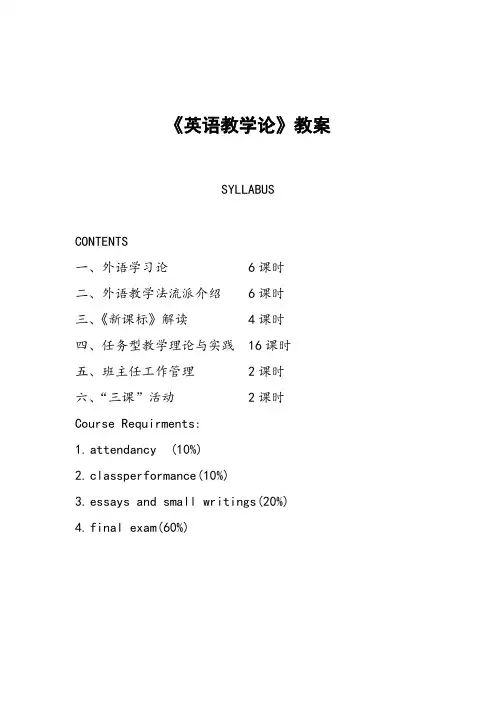
《英语教学论》教案SYLLABUSCONTENTS一、外语学习论 6课时二、外语教学法流派介绍 6课时三、《新课标》解读 4课时四、任务型教学理论与实践 16课时五、班主任工作管理 2课时六、“三课”活动 2课时Course Requirments:1.attendancy (10%)2.classperformance(10%)3.essays and small writings(20%)4.final exam(60%)主要备课资料:1、张正东:《外语教育学》。
科学出版社,1999年。
2、张正东、李少伶:《英语教学论》。
陕西师范大学出版社,2003年。
3、张正东、杜培俸:《外语立体化教学法的原理与模式》。
科学出版社,1998年。
4、胡春洞:《英语教学法》。
高等教育出版社,1990年。
5、王才仁:《英语教学交际论》。
广西教育出版社,1996年。
6、胡春洞、戴忠信:《英语阅读论》。
广西教育出版社,1998年。
7、高兰生、陈辉岳:《英语测试论》。
广西教育出版社,1996年。
8、聂希庸、曹宝健:《中学英语教学》。
光明日报出版社,1998年。
9、程晓堂:《任务型语言教学》。
高等教育出版社,2004年。
10、田式国:《英语教学理论与实践》。
高等教育出版社,2001年。
11、宋桂月、金莺:《英语课程标准教师读本》。
华中师范大学出版社,2002年。
12、鲁子问:《中小学英语真实任务教学实践论》。
外语教学与研究出版社,2003年。
13、梁祝、卢福波:《小学英语新课程课堂教学案例》。
广东高等教育出版社,2003年。
14、程可拉、刘津开:《中学英语任务型教学理念与教学示例》。
华南理工大学出版社,2005年。
15、张玲棣:《高中英语课堂教学设计与案例》。
高等教育出版社,2004年。
16、于勇:《中小学课堂教学技能训练》。
当代世界出版社,2001年17、顾曰国:《英语教学法》(上下)。
外语教学与研究出版社,1998年。
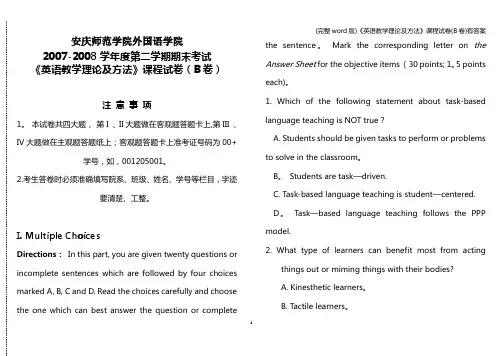
安庆师范学院外国语学院2007-2008学年度第二学期期末考试《英语教学理论及方法》课程试卷(B卷)注意事项1。
本试卷共四大题,第I 、II大题做在客观题答题卡上,第III 、IV大题做在主观题答题纸上;客观题答题卡上准考证号码为00+学号,如,001205001。
2.考生答卷时必须准确填写院系、班级、姓名、学号等栏目,字迹要清楚、工整。
I. Multiple ChoicesDirections:In this part, you are given twenty questions or incomplete sentences which are followed by four choices marked A, B, C and D. Read the choices carefully and choose the one which can best answer the question or complete the sentence。
Mark the corresponding letter on the Answer Sheet for the objective items (30 points; 1。
5 points each)。
1. Which of the following statement about task-based language teaching is NOT true?A. Students should be given tasks to perform or problems to solve in the classroom。
B。
Students are task—driven.C. Task-based language teaching is student—centered. D。
Task—based language teaching follows the PPP model.2. What type of learners can benefit most from actingthings out or miming things with their bodies?A. Kinesthetic learners。

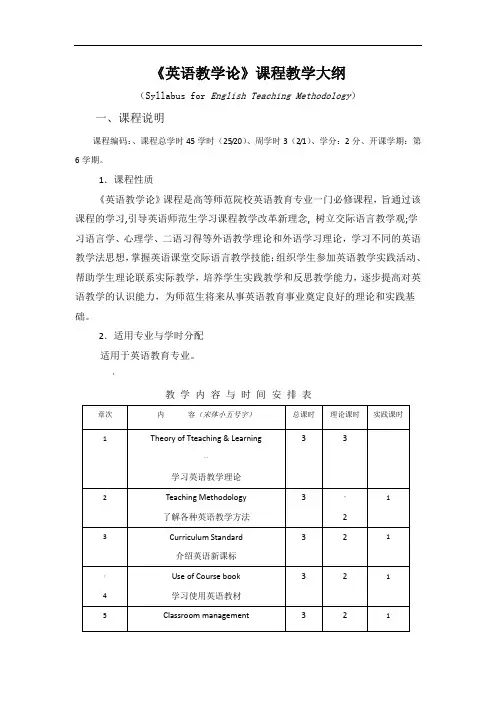
《英语教学论》课程教学大纲(Syllabus for English Teaching Methodology)一、课程说明课程编码:、课程总学时45学时(25/20)、周学时3(2/1)、学分:2分、开课学期:第6学期。
1.课程性质《英语教学论》课程是高等师范院校英语教育专业一门必修课程,旨通过该课程的学习,引导英语师范生学习课程教学改革新理念, 树立交际语言教学观;学习语言学、心理学、二语习得等外语教学理论和外语学习理论,学习不同的英语教学法思想,掌握英语课堂交际语言教学技能;组织学生参加英语教学实践活动、帮助学生理论联系实际教学,培养学生实践教学和反思教学能力,逐步提高对英语教学的认识能力,为师范生将来从事英语教育事业奠定良好的理论和实践基础。
2.适用专业与学时分配适用于英语教育专业。
*教学内容与时间安排表3.课程教学目的与要求:I.教学目的:通过《英语教学论》课程的学习,帮助英语师范生具有新课程教学改革的理念和职业规范与师德,掌握一定的外语教学理论和外语学习理论,了解交互性语言教学的课堂教学理论基础,培养英语教学实践经历和反思教学的的能力,促进师范生在学术上的可持续发展的基本素质。
II.教学要求:教师通过多媒体讲授英语教学理论、教学流派、课程标准和教学原则等知识后,组织师范生进行小组为单位的教学内容演示等教学实践活动,提高师范生对英语教学本质的认识,使他们一定的理论高度,具备反思教学的可持续发展的能力,逐步完善自己的英语教学能力。
4.本门课程与其它课程关系本课程是在第6学期开设的专业基础必修课,学生已经学习了英语专业的一些基础课程以及一些相关的通识课之后才开设,本门课程的开设对巩固和提高英语教师专业学生的专业素质会起到积极作用。
它既能够优化教育理论课程,如心理学、教育学等,同时也能够检验学生对所学英语专业知识的把握程度及综合运用英语语言的能力。
5.推荐教材及参考书推荐教材:Davies, Eric Pearse Success in English Teaching Shanghai Foreign Language Education Press, 20052.王蔷:《英语教学法教程》,高等教育出版社,2000年。
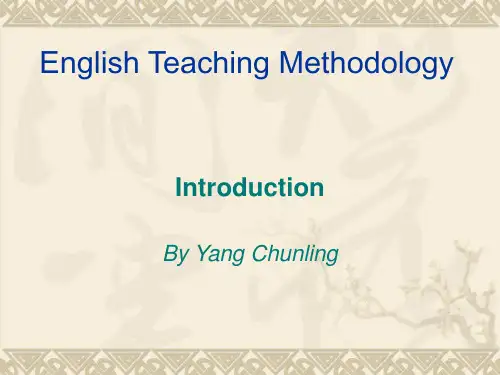
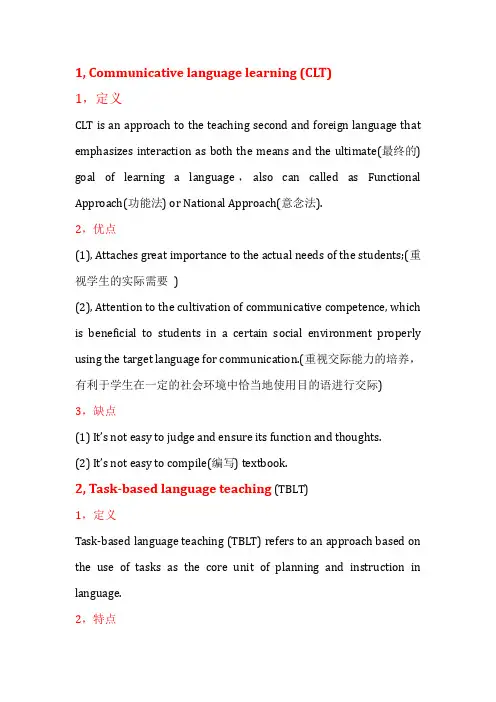
1, Communicative language learning (CL T)1,定义CLT is an approach to the teaching second and foreign language that emphasizes interaction as both the means and the ultimate(最终的) goal of learning a language,also can called as Functional Approach(功能法) or National Approach(意念法).2,优点(1), Attaches great importance to the actual needs of the students;(重视学生的实际需要)(2), Attention to the cultivation of communicative competence, which is beneficial to students in a certain social environment properly using the target language for communication.(重视交际能力的培养,有利于学生在一定的社会环境中恰当地使用目的语进行交际)3,缺点(1) It’s not easy to judge and ensure its function and thoughts.(2) It’s not easy to compile(编写) textbook.2, Task-based language teaching (TBLT)1,定义Task-based language teaching (TBLT) refers to an approach based on the use of tasks as the core unit of planning and instruction in language.2,特点1, Emphasis -Target language2, Focus on – the learning Process & language itself3, It is student-centered class4, It pays attention to real situations3,优点(1), c an stimulate students’ interest,2(2), students have more opportunities to express their own opinions and feelings.(3),It can improve their exploration, participation, communication and cooperation ability.4,缺点(1) The classroom efficiency is low.(2) It is difficult to guarantee the big class teaching task.(3) It is rely on teachers’ teaching ability and teaching level.3, The Oral Approach and Situational Language Teaching1, 背景Situational Language Teaching was originally called Oral Approach, which was developed by British applied linguists from the 1930's to 1960’s; the two leaders of this movement were Harold Palmer and A.S. Hornby.2, 定义The Oral Approach and Situational Language Teaching is a languageteaching method derived from the Direct Method and developed by British applied linguists between 1930s and 1960s. The Method is no longer in fashion, but some techniques from the Method can still be found in language teaching activities and especially in many textbooks.3, 目标(1) to teach a practical command of the four basic skills of language, through Structure.(2)accuracy in both pronunciation and grammar.(3) errors to be avoided.(4)automatic control of basic structures and sentence patterns through speech.4, 方法:Theory of Language Behaviorist habit-learning theory:Three conditions:1. Receiving knowledge and materials2. Fixing them in memory by repetition3. Using them in actual practiceLearning language is to learn speech habitsUse of blind imitative drills5, 角色Learner roles: Listen and repeat / more active participationTeacher roles: Serves as a model, Conductor of an orchestraThe roles of instructional materials: SLT is dependent on both a textbook and visual aids.1. Begin with spoken English, oral before written form2. The target language is the language of the classroom3. New language points: Introduced and practiced4. Selection: Cover the general service vocabulary5. Simple forms at first and then complex ones6. Rich vocabulary and basic grammar (Reading and Writing)6, 优点It strong emphasis on oral practice, grammar and sentence patterns conforms to the intuitions of many practically oriented classroom teachers.7, 缺点Children do not acquire their mother tongue through repetition and habit formation.8, 特点The essential features of SLT are seen in the "P-P-P" lesson model that thousands of teachers who studied for the RSA/ Cambridge Certificate in TEFL were required to master in the 1980s and early 1990s, with a lesson having three phrases: Presentation, Practice, and Production.4,The Audio-lingual Method1, 定义The Audio-lingual Method is a method of foreign language teaching which emphasizes the teaching of listening and speaking before writing and reading.2,特点It uses dialogues as the main form of language presentation and drills as the main training techniques. Mother tongue is discouraged in the classroom.3,基本原则(1)Emphasis on the teaching of listening and speaking.(2)Use of dialogues as the chief means of presenting the language.(3)Mainly practice techniques: imitation, memorization, pattern drills.(4)Mother tongue is discouraged in the classroom.5,Total Physical Response (TPR)1,定义In the teaching activities, teacher creates a happy relaxed environment. Meanwhile students respond with whole-body actions. The right brain is silent, nonverbal, but it can make adaptation action to express them through instruction.2,特点TPR emphasizes the importance of listening and watching. The teacher issued instructions and they complete the action.This method is suitable for little children to study foreign language; as a result of they have interests for everything around them.3,优点TPR makes complex knowledge easier than before. For example, teachers can have a dialogue with our students and build the English context in order to simplify knowledge6,暗示法Suggestopedia定义:The approach was based on the effect of suggestion in learning, the concept of which is that positive suggestion would make the learner more receptive to stimulate learning特点1,To create a cheerful, relaxing atmosphere2,The authoritative behavior of the teacher and the authority of the material3,Emphasis on memorization of vocabulary pairs4,Infantilization(稚化): Role playing games, songs and gymnastic exercises help students regain their self-confidence.5,Double-planeness: learners learn from the effect of direct instruction and the environment where the instruction takes place.优点Creating a relaxing and comfortable environmentReducing students’ pressure in learning languageAvoid boredom and making class interestingImp roving students’ motivation of learning缺点Not all teachers are qualified for this methodRequiring money to decorate the classroomThe number of students is limitedLasting a long time for teaching every day8,团体学习法Community Language Learning (CLL)1,定义Community Language Learning is an approach in which students work together to develop what aspects of a language they would like to learn.It is based on the Counseling-approach in which the teacher acts as a counselor and a paraphraser, while the learner is seen as a client and collaborator.2,特点(1)The CLL emphasizes the sense of community in the learning group, it encourages interaction as a vehicle of learning, and it considers as a priority the students' feelings and the recognition of struggles in language acquisition. There is no syllabus or textbook tofollow and it is the students themselves who determine the content of the lesson by means of meaningful conversations in which they discuss real messages. Notably, it incorporates translation, transcription, and recording techniques.(2)Student’s role-client(3)Teacher’s role-counselor3,优点A brave speakerNo fixed teaching materialsAcquire answer the questionsIntrospection4,缺点Demand too high on teacherRely on9,自然学习法The natural approach is a method of language teaching developed by Stephen Krashen and Tracy Terrell in the late 1970s and early 1980s.It aims to foster naturalistic language acquisition in a classroom setting, and to this end it emphasizes communication, and places decreased importance on conscious grammar study and explicit correction of student errors. Efforts are also made to make the learning environment as stress-free as possible.In the natural approach, language output is not forced, but allowed to emerge spontaneously after students have attended to large amounts of comprehensible language input.优点(1)The classroom consisting of acquisition activities can be an excellent environment for beginners.(2)Comprehensible and meaningful practice activities are emphasized and the situation at their level.(3)The teacher creates speeches which enable students to interact using the target language.(4) Communication as the primary function of language and emphasis on meaning.(5)Students are not forced to respond in the target language immediately.(6)The teacher knows students’ needs and concentrates on appropriate and useful areas.(7)Materials come from our daily life rather than from textbooks.缺点(1)It ignores many factors essential in second language course design.(2)It ignores the importance of vocabulary.(3)It not necessary to analyze grammatical structure & rulesautomatically provided in the input.(4)It is suitable for the beginners, not apply to the high level students.。
第四章1. 根据卡南尔和斯温纳(Canale and Swain)的论述,交际能力包括语法能力、社会语言能力、篇章能力和____。
A. 语汇能力B. 词汇能力C. 语言能力D. 策略能力Key: D (pp. 75)2. 英国语言哲学家奥斯汀认为,人在说话的时候同时施行着以言述事、以言成事和_________三种行为。
A. 以言做事B. 价值判断C. 表情达意D. 发出指令Key: A (pp. 77)3. 韩礼德认为,语言的微观功能包括工具功能、个人功能、启发功能、想象功能、信息功能和_______及______。
A. 策略功能、思维功能B. 相互关系功能、规章功能C. 篇章功能、人际功能D. 思维功能、篇章功能Key: B (pp. 74)4. 一些学者从社会交际功能的角度出发,探讨________和________的理论。
A. 语言学习和交际能力B. 语言使用和交际能力C. 语言使用者和语言使用D. 语言使用者和语言能力Key: C (pp. 75)5.海姆斯的交际能力包括:懂的形式上的可能、能判断语言形式的可行性、_________和__________。
A. 能在交际中得体地使用;知道某些话语能否实际说出来B. 拥有社会语言能力;拥有语篇能力C. 拥有策略能力;拥有篇章能力;D. 拥有策略能力;拥有社会语言能力;Key: A (pp. 75)6.英国语言哲学家奥斯汀的理论中,可以验证,可以是真实或错误的陈述的句子类型是________。
A. 行为句B.叙述句C. 受约句D. 指令句Key: B (pp. 77)7. 意念大纲的诞生和___________理论有密切关系.A. 海姆斯的交际能力理论B. 奥斯汀的言语行为理论C. 韩礼德的功能学派D. 卡南尔和斯温纳的理论Key: B (pp. 78)8. 外语学习理论可以分为两种,一种是探究外语学习普遍性和规律性的研究,另一种是__________。
《英语教学论》教案一、教学目标1. 了解英语教学的基本原则和方法。
2. 掌握英语教学设计的基本步骤。
3. 熟悉英语教学评价的标准和手段。
4. 提高英语教学实践能力。
二、教学内容1. 英语教学的基本原则2. 英语教学方法3. 英语教学设计4. 英语教学评价5. 英语教学实践三、教学方法1. 讲授法:讲解英语教学的基本原则、方法和评价手段。
2. 案例分析法:分析典型英语教学设计案例,讨论其优点和不足。
3. 小组讨论法:分组讨论英语教学实践中遇到的问题,分享经验。
4. 模拟教学法:进行模拟教学,提高学员的英语教学能力。
四、教学安排1. 第一课时:英语教学的基本原则2. 第二课时:英语教学方法3. 第三课时:英语教学设计4. 第四课时:英语教学评价5. 第五课时:英语教学实践五、教学评价1. 课堂参与度:评估学员在课堂讨论、提问和分享经验方面的积极性。
2. 模拟教学效果:评估学员在模拟教学中的表现,包括教学内容、方法和组织能力。
3. 课后作业:评估学员对教学内容的掌握程度,以及运用所学知识解决实际问题的能力。
4. 期末考试:全面测试学员对英语教学理论和实践的掌握程度。
六、教学资源1. 教材:《英语教学论》教材,用于讲解基本理论和知识点。
2. 案例库:收集各类英语教学设计案例,用于分析和讨论。
3. 模拟教学材料:提供模拟教学所需的教材、课件等资源。
4. 视听资料:播放优秀英语教学视频,供学员学习借鉴。
5. 在线资源:推荐相关英语教学网站和论坛,便于学员课后学习和交流。
七、教学过程1. 导入:每节课开始时,用几分钟时间引导学员回顾上节课的内容,为新课的学习做好铺垫。
2. 讲解:详细讲解本节课的教学内容,通过案例分析、互动讨论等方式,帮助学员理解和掌握知识点。
3. 实践:安排模拟教学环节,让学员亲自动手实践,提高教学能力。
4. 总结:每节课结束前,对所学内容进行总结,强调重点和难点。
5. 作业布置:布置课后作业,巩固所学知识,培养学员独立思考和解决问题的能力。
湖南师范大学硕士研究生入学考试自命题考试大纲
考试科目代码:[971] 考试科目名称:英语教学论
一、考试形式与试卷结构
1.试卷分值及考试时长
本试卷满分为150分,考试时长为180分钟。
2.答题方式
答题方式为闭卷、笔试。
3.试卷结构
第一部分:英语教学理论基本知识
(1)名词解释题:6道题,每题5分,共计30分。
(2)简答题:4道题,每题15分,共计60分。
第二部分:英语教学理论基本知识运用
分析论述题:3道题,每题20分,共计60分。
二、考试内容与考试要求
1.考试内容
(1)学科教学论:优秀教师的基本素养;交际能力、语言教学的交际原则;任务及任务型教学;新课程标准;教案设计;课堂管理;语言知识教学与跨文化意识培养;语言技能教学与综合语言技能教学;形成性评价与终结性评价;教材评估、选择及开发利用;外语教学法主要流派及其发展脉络。
(2)第二语言习得:第二语言习得的定义;一语与二语习得的差异;第二语言习得的途径与习得顺序;中介语;影响第二语言习得的外部因素;输入、互动、输出对习得的影响;母语的作用;学习者差异对二语习得的影响;课堂教学对二语习得的作用;二语习得理论及其发展脉络。
2.考试要求
(1)能比较系统地掌握英语学科教学及第二语言习得的核心概念、基本知识、基础理论与基本方法;
(2)能熟练运用学科教学论及第二语言习得的基本理论和方法分析、解决教学中的实际问题;
三、参考书目
1.王蔷:《英语教学法教程》(第二版),高等教育出版社,2006年。
2.束定芳、庄智象:《现代外语教学:理论、实践与方法》(修订版),上海外语教育出版社,2008年。
3.Ellis,R. Understanding Second Language Acquisition(《第二语言习得概论》),上海外语教育出版社,1999年。